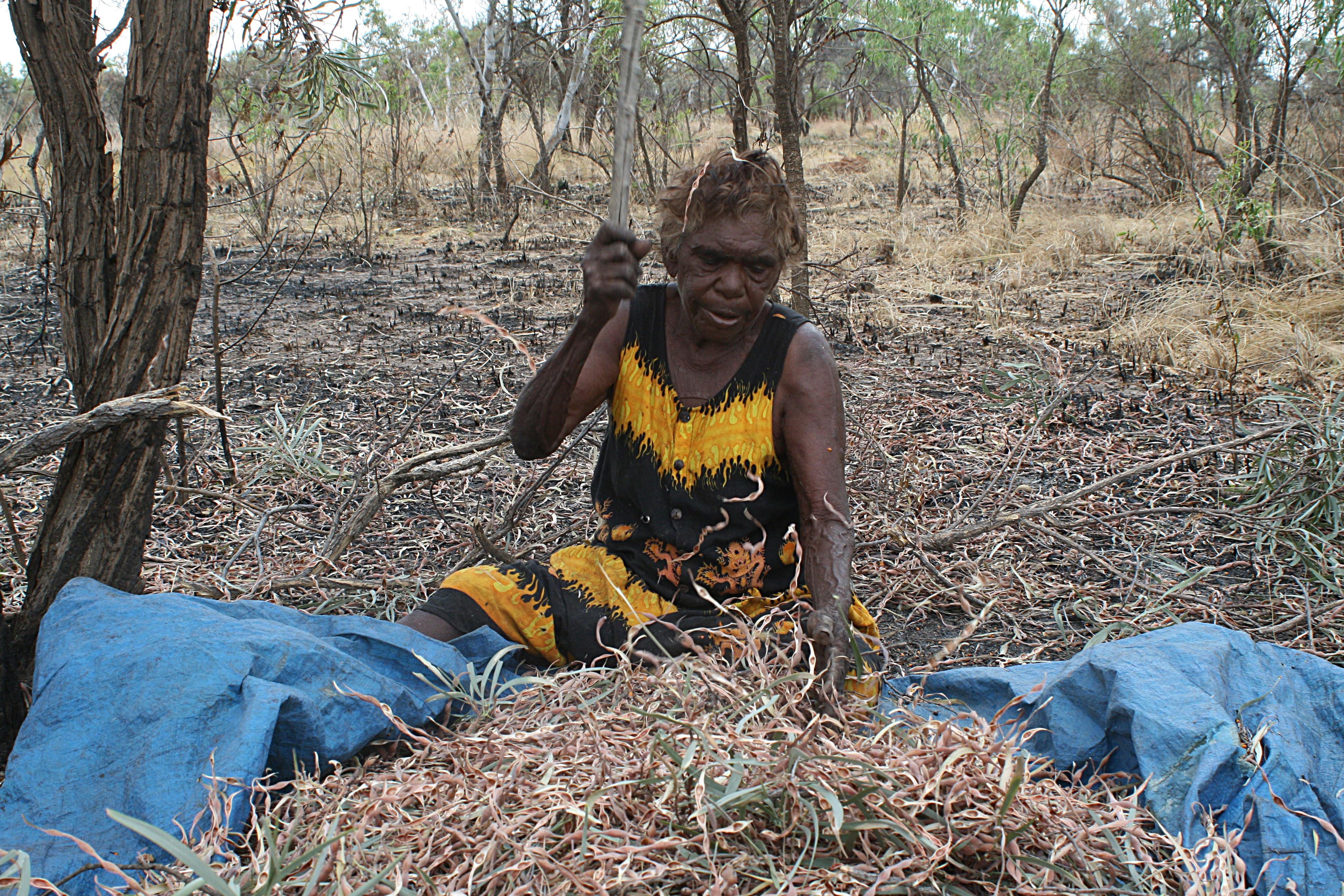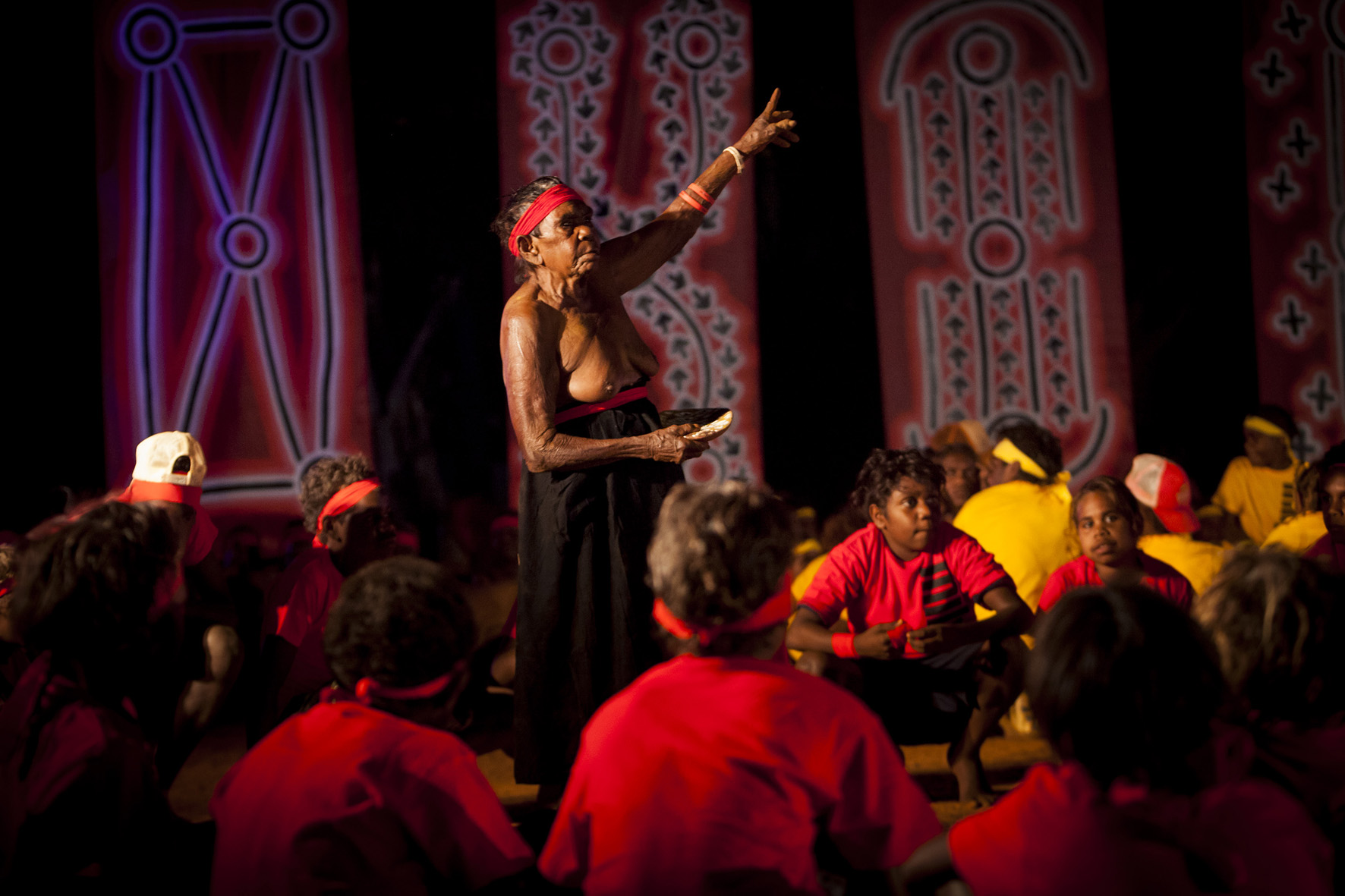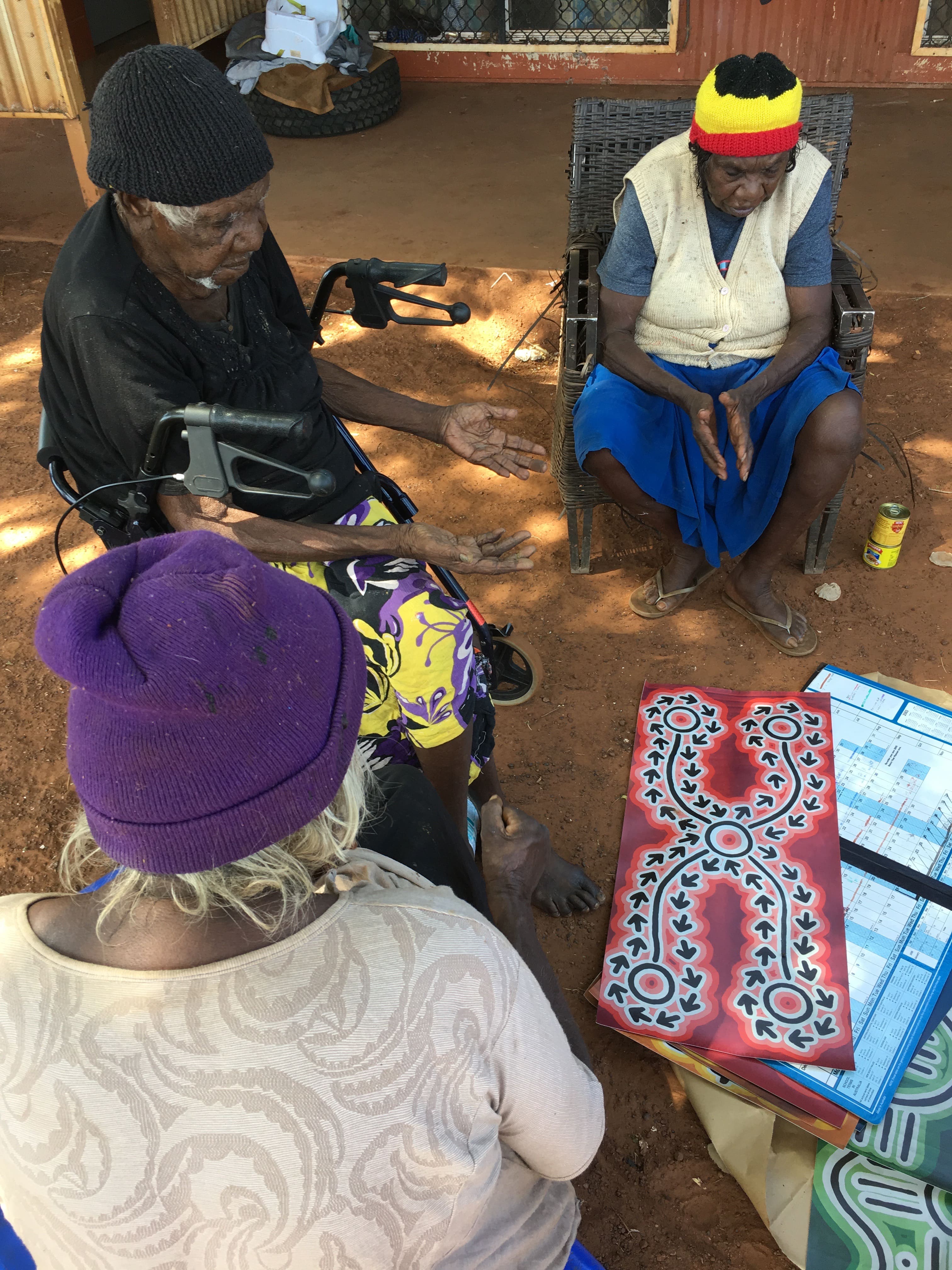Milpirri Banner - KURLUKUKU (Diamond Dove)
Biology
About the Kurlukuku (Diamond Dove) - Photo / Information
Calls
Kuruluku is one of many Warlpiri bird names that are onomataphaic. That is, the Warlpiri names sound like the call of the bird.
Hear the Kurlukuku (Diamond Dove) call - Video
Dreaming Design
Myra Herbert Nungarrayi and Molly Tasman Napurrurla state that the design shows the tracks of the Kurlukuku (diamond dove) birds. These are the “arrow” shapes moving around the outside of the design. The birds are going around stealing the seeds. They go around and take them from one place and leave them in another. The circles in the design are the piles of seeds. They say, “The Tennant Creek mob have this dreaming at Pawurrinji and Jipirinpa.” (Myra is a ritual manager or kurdungurlu for this dreaming and Molly is a custodian or owner, called kirda in Warlpiri.)
Belonging to Skin Groups
Jupurrula, Jakamarra, Napurrurla and Nakamarra (Red Group)
Drawn By
Tim Jupurrula Kennedy (dec), or Jacko Jakamarra Gordon (dec) 2005
Artist Biography
Tim Jupurrula Kennedy: Born at Mt Singleton c.1947 of the Warlpiri tribe and language. His country was Mt Singleton and he lived at Lajamanu. His dreamings are Kurrkurrpa, Waringarri, and Jurntu. He painted with his wife, Iris Dixon, and also with Abie Jangala, and started painting in 1986. He was an excellent craftsman and was often seen with his friend Teddy Morrison collecting timber for boomerangs, shields and coolamons. He was an early and strong supporter of the Warlpiri ranger program.
See some of Tim Jupurrula Kennedy paintings within the National Gallery of Victoria online collection - Photo
Place
According to Myra Herbert Nungarrayi and Margret Nungarrayi Martin, a key site for the Kurlukuku dreaming is Miya Miya which is on the old road between Lajamanu and Tennant Creek, on the way to Emu Bore. The women camped there on a Central Land Council trip in 2016. The site is not far east from Kurlurrngalinypa
See and read about Kurlurrngalinypa on its Milpirri Banner page - Photo / Information
Rosie Napurrurla Tasman (dec) explains her Ngurlu (seed) and Kurlukuku (Dove) dreamings (1991) in Barbara Glowczewski, (2001) Dream Trackers: Yapa Art and Knowledge of the Australian Desert. (Multi-Media Recordings of Lajamanu Area.) Paris: UNESCO
“The Kurlukuku travelled through Jarralpirri, Kuuku, Karaangu, Kunalarunyu, Yartuluyartulu (the granites), Pawurindju, Kurkumindi and Jawalarra. The painting shows the dove milk transformed into black seeds and white seed and a seekcake in a parraka dish. There are also the two dove women, a Nakamarra and her aunt Napurrurla who made her cry by stealing her grinding stone. Both live forever underground at Parwuinji.” (Parwuinji is west of Tennant Creek.)
Tennant Creek - Map
Rosie Napurrurla Tasman describing her Grass Seed Dreaming painting with links to Kurlukuku: “This story is for the Napurrula and Nakamarra women (aunts and nieces) and Jupurrurla and Jakamarra men (fathers and sons) skin groups. The painting tells the Jukurrpa or dreaming story about the women following the tracks of the bush pigeon, Kurlukuku, in order to find and gather grass seeds. The pigeon gathers the seeds that have fallen to the ground while the women gather seeds from the long stems and use them to make damper. The seeds were collected in coolamons and taken home to be sorted ready for grinding. The ground seeds are then ready to be made into damper. The elongated oval shapes in the centre of the print represent coolamons in which the women are collecting the stems and grains. They also represent the dampers the women cook. Along the outside, Rosie has depicted trees and clapsticks that are partially obscured by the design. These music sticks are used when Rosie sings and dances this particular dreaming during ceremony. The song is sung by the men and the women. It is known to bring men and women closer as it ties in with the Majardi song cycle central to Warlpiri Yilpinji love magic. This dreaming takes place near the Granites in the Tanami desert at a place called Miya Miya.
Traditional Owner Profile
Rosie Napurrurla Tasman (deceased 2018). Rosie was born at Pawarla, north of the Granites area in the Tanami Desert. She has ancestral rights over the Wampana (wallaby), Janganpa (possum), Ngurlu (seed) and Kurlukuku (bush pigeon) dreamings, which were passed from her father, Wayipurlungu.
Tasman’s traditional country, Miya Miya and Pawarla and the Dreamings associated with these particular sites, provide the inspiration and imagery for her distinctive paintings. She says that painting provides her with a ‘happy way’ in which to make her culture strong.
Rosie Napurrurla Tasman was first introduced to the medium of acrylic paint in 1986 when the first works from Lajamanu were created for a public audience. Since then, painting has played a fundamental role in the ritual and ceremonial life of her family. Both of her siblings, Teddy Japurrurla Morrison and Molly Napurrurla Tasman are established artists in the Lajamanu community, and her daughter Denise Napangardi Robertson is one of the younger generations of Warlpiri artists.
Tasman’s work alternates between intricate dotted circular motifs and bold gestural brush strokes. Her palette oscillates from traditional ochre colours to a freer application of bright yellows, reds and blues. In her Janganpa (possum) dreaming, she employs a technique of a white monochrome background to enhance the kuruwarri (ancestral designs) of the Janganpa ancestor and his travels across the country. Her Ngurlu (seed) dreamings employ a technique where the iconography of the seed is mirrored in a background circular pattern of dots. This reinforces the essential elements of the seed dreaming.
Rosie has also been a key member of the Lajamanu community on all issues relating to country, hunting and traditional knowledge. She is an active member of the North Tanami Protected Area and has been a key person in establishing the ranger program. Rosie is an expert hunter of both animals and plant food. During a commercial venture in 2005, Rosie was easily the most experienced and prolific collector of Acacia Coreacia seed for sale to commercial buyers in Alice Springs.
Read more about Rosie Napurrurla Tasman from the Australian Art Network - Photo / Story
Kurdungurlu
In Lajamanu Myra Herbert Nungarrayi and Margaret Martin Nungarrayi.
Latin
Geopelia cuneate
Language Stories
Kurlukuku, ngulakarnalu ngarrirni jirripirdiyijala. Kurlukukuju ka nyinami wajirrki-wajirrki palkaji - yangka pinkirrpaji. Milpaji tirirtiri. Walungku ka mardarni jirtawarnu wita. Walungkaji kankarlarni karla karrimi.
The Diamond Dove, is a name we give to another bird. The Diamond Dove has blue-green body feathers. It has red eyes. Its head has a small crest which stands out from the top of its head.
Jukurrpa Kurlukuku, ngulaji Pawurrinji-wardingki.
The Diamond Dove Dreaming is from Pawurrinji.
Dictionary Source: Laughren, M., K. L. Hale, and Warlpiri Lexicology Group, 2005 Warlpiri-English Encyclopaedic Dictionary. (Accessed Via Kirrkirr Interface to Electronic Files.) The University of Queensland.
Traditional Knowledge
The ‘Paku-paku’ (Crested Bellbird [Oreoica Gutturalis]) and ‘Kurlukuku’ (Diamond Dove [Geopelia Cuneata]) are messengers of love songs.
On becoming the ancestor in dance
When Warlpiri perform ceremony they dance the ancestor. Warlpiri elder Jerry Jangala states that in dance one becomes the ancestor, reinhabiting their body, and their actions in the dreamtime. This revitalises the ancestor energy and the life energy of the living species.
Warlpiri anthropologist Jennifer Biddle elaborates: ‘There can be reciprocity – exchange between Ancestor and Yapa [Warlpiri people] – because there is alterity – someone else to exchange with. What lies between the two – ‘skin’ – is not so much a border as a certain bridging potentiality. This intercorporeality makes for what Yapa describe when witnessing a particularly good yawulyu: they don’t say, for example, that Napurrurla is performing or enacting a particularly convincing Ngurlu or Kurlukuku dreaming (Mulga seed/ and or Diamond Dove dreaming) – as we might speak of an actor’s successful ‘portrayal’ or ‘depiction’ but indeed, Yapa say that she really is ‘that one now, that Kurlukuku, that Diamond Dove.’
Source: Biddle J, 2001, 'Inscribing Identity: Skin as Country in the Central Desert', in Ahmed S Stacey J (ed.), Thinking Through the Skin, Routlege, London and New York.
Milpirri Dance
In 2012 Milpirri (Pulyarani) the women danced Kulukuku (Diamond Dove). In the action of the dance: They grind the seeds up and make mangarri (damper) and eat it. Two Kulukuku are crying for ngurlu (seeds) to eat because they are still hungry - Video
Some families to learn more from
Rennie, Morrison and Tasman


![Kuruluku (Diamond Dove). Image attribution: By Christopher Watson (http://www.comebirdwatching.blogspot.com/) [CC BY-SA 3.0 (https://creativecommons.org/licenses/by-sa/3.0)], via Wikimedia Commons.](/sites/default/files/banners/photos/Diamon_dove_-_Christopher_Watson.jpg)


